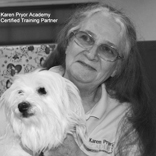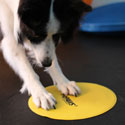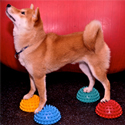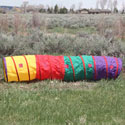
Helix Fairweather became interested in the skills dogs need—and too often do not have—to play happily with other dogs. She decided to launch a series of Dog Park play sessions to allow skilled dogs to teach other dogs the art of playing and to teach handlers the observation skills necessary to understand canine communication.
Fluency in canine body language is established during puppyhood if sufficient interaction with other dogs has occurred. If not, play times with other dogs can be peppered with inappropriate behaviors that are likely to be greeted with snarls and snaps. Helix describes these behaviors as "problems such as fixating on one mode of interaction with another dog (for example, mounting, front leg over shoulders, body slamming). Jean Donaldson refers these dogs as ‘play skills deficit.' This is a fixable behavior but requires other dogs for context."
At Helix's Dog Park sessions, dogs with social skills were allowed to interact with play-skills deficit dogs. While the sessions would educate the dogs, the human handlers in attendance would also learn "about appropriate dog play, how and when to let dogs work out how to play together and shift roles, learning when to intervene and help a dog learn to change his behavior."
While Helix's Dog Park sessions did not employ clicks or other marker signals, the observation skills fundamental to effective clicker training were key to the success of the series. "My goal in doing the Dog Park sessions is that dogs learn to play properly from other dogs and that humans learn how to let that happen," says Helix.
"Our success comes from having the right dogs to do the teaching and from a background of being clicker trainers (most of us). We have an eye for fine nuances of behavior and for looking at behavior as ‘only' behavior rather than looking through a condemning label usually applied to a dog's character. We're also geared to observing a behavior in one dog and watching for the response in the other dog. For example, a paw placed over another dog's back is just a behavior. It's not a character defect; it's just a behavior. What is most important is what does the other dog do as a result of the paw on his back? Does he work to shift the play? If so, does the paw-putting-dog learn that putting paws up isn't going to be part of how we play well? We learn to watch for more than what people usually call offensive and inappropriate behavior. We watch for the whole scenario. Who did what, how did play change, who is learning what. We also learn to watch for escalated arousal in the problem dog so that he can be interrupted a la Donaldson's ‘interrupter' process. It's a fine art—when to allow what happens next to unfold versus when play is heating up and someone needs the interrupter."
The communication—and training—skills of the dogs who know how to play fluently has astonished the handlers at the sessions. Helix again: "I rely on having the right dogs present for dog-to-dog learning to take place. We have two dogs that are active splitters and are highly respected by the other dogs. I call these the ‘good teacher' dogs. We have at least one dog that has such ‘presence' that all the other dogs just ‘get it.' Those three dogs do most of their teaching via corrective communications. We have one dog, Daisy the Beardie, who teaches in a totally different way. Daisy is just a joy to watch. She's four years old and really growing into her role as an elder. Upstarts charge at her and she drops out from under them in a flat down—she's a master at Tai C'hi. She just deflects their energy. She teaches dogs to play while laying in a down and she works really hard to use positive reinforcement for the things they do right. She's amazing! She does have to give off a correction occasionally but her first tactic is positive reinforcement!"
To read more about Helix Fairweather's Dog Park Series, visit the Dog Park blog or come to ClickExpo this season to meet her in person!








Post new comment